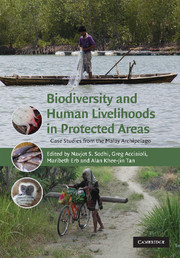Book contents
- Frontmatter
- Contents
- List of contributors
- Acknowledgements
- 1 General introduction
- Part I Conservation needs and priorities
- Part II Conservation with and against people(s)
- 11 Introduction to Part II
- 12 Collaboration, conservation, and community: a conversation between Suraya Afiff and Celia Lowe
- 13 Hands off, hands on: communities and the management of national parks in Indonesia
- 14 Conservation and conflict in Komodo National Park
- 15 Another way to live: developing a programme for local people around Tanjung Puting National Park, Central Kalimantan
- 16 For the people or for the trees? A case study of violence and conservation in Ruteng Nature Recreation Park
- 17 Seas of discontent: conflicting knowledge paradigms within Indonesia's marine environmental arena
- 18 Strategy and subjectivity in co-management of the Lore Lindu National Park (Central Sulawesi, Indonesia)
- 19 Indigenous peoples and parks in Malaysia: issues and questions
- 20 Protecting Chek Jawa: the politics of conservation and memory at the edge of a nation
- 21 Integrating conservation and community participation in protected-area development in Brunei Darussalam
- 22 Conclusion to Part II
- Part III Legal and governance frameworks for conservation
- 29 General conclusion
- Index
- References
21 - Integrating conservation and community participation in protected-area development in Brunei Darussalam
from Part II - Conservation with and against people(s)
Published online by Cambridge University Press: 12 November 2009
- Frontmatter
- Contents
- List of contributors
- Acknowledgements
- 1 General introduction
- Part I Conservation needs and priorities
- Part II Conservation with and against people(s)
- 11 Introduction to Part II
- 12 Collaboration, conservation, and community: a conversation between Suraya Afiff and Celia Lowe
- 13 Hands off, hands on: communities and the management of national parks in Indonesia
- 14 Conservation and conflict in Komodo National Park
- 15 Another way to live: developing a programme for local people around Tanjung Puting National Park, Central Kalimantan
- 16 For the people or for the trees? A case study of violence and conservation in Ruteng Nature Recreation Park
- 17 Seas of discontent: conflicting knowledge paradigms within Indonesia's marine environmental arena
- 18 Strategy and subjectivity in co-management of the Lore Lindu National Park (Central Sulawesi, Indonesia)
- 19 Indigenous peoples and parks in Malaysia: issues and questions
- 20 Protecting Chek Jawa: the politics of conservation and memory at the edge of a nation
- 21 Integrating conservation and community participation in protected-area development in Brunei Darussalam
- 22 Conclusion to Part II
- Part III Legal and governance frameworks for conservation
- 29 General conclusion
- Index
- References
Summary
Introduction
The importance of local community participation has never been more underscored than in protected-area development. The World Conservation Strategy acknowledged the need to involve local communities in rural development in terms of labour, funds, land and materials, by linking protected-area management and development with the economic activities of local communities (IUCN 1980). It recommended that local communities should be able to share the benefits from recreation and tourism, both directly and indirectly, through the provision of public services such as roads, water supply and health facilities.
Concurrently, the World Tourism Organization (WTO) and the United Nations Environment Programme (UNEP) voiced similar concerns through a joint declaration on tourism and environment drawn up in 1983 (WTO & UNEP 1992). Both organizations encouraged more appropriate tourism development in national parks and protected areas by addressing the ways and means of involving local people living in and around protected areas so that they may obtain increased social and economic benefits from tourism. The World Tourism Organization and the United Nations Environment Programme further developed guidelines in developing national parks and protected areas for tourism, which state that in identifying their primary beneficiaries, the local people ‘should have the highest priority’ (1992:23).
The Fourth World Congress on National Parks and Protected Areas also adopted the need to include local people in park planning and management (McNeely 1992).
- Type
- Chapter
- Information
- Biodiversity and Human Livelihoods in Protected AreasCase Studies from the Malay Archipelago, pp. 330 - 342Publisher: Cambridge University PressPrint publication year: 2007



